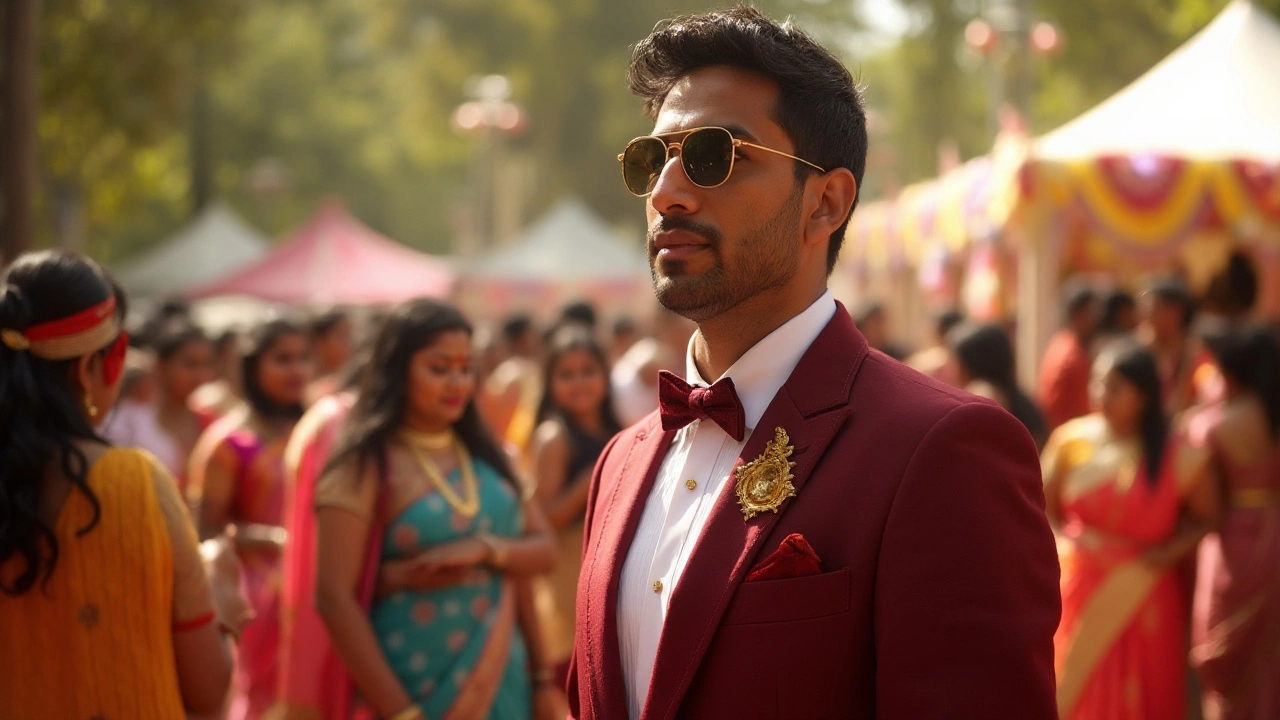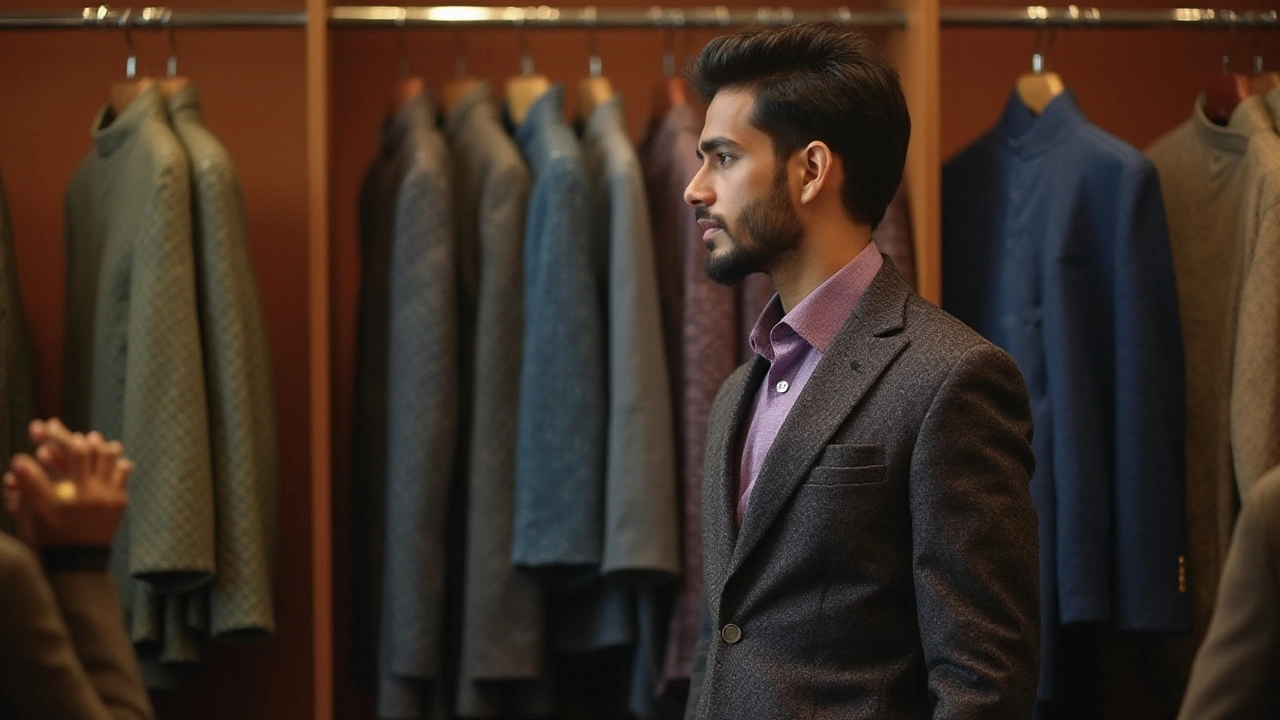The Best Suit Colors for Men: A Comprehensive Guide

When it comes to men's suits, color plays a crucial role in defining style and appropriateness for different occasions. Picking the right shade isn't just about preference; it can impact how you're perceived in both professional and social settings.
Traditionally, suits have come in a spectrum of colors, with each hue offering its unique flair and purpose. Some colors resonate with timeless elegance, while others cater to modern trends. In this guide, we'll dive into the world of suit colors, exploring which hues are best for the boardroom, a night out, or even a wedding.
Whether you're drawn to the basics or feel adventurous enough to try bold shades, understanding these nuances is key. So, consider this your go-to resource as we explore the power of color in men's suiting.
Classic Colors
When we talk about men's suits, classic colors always top the conversation. These hues have stood the test of time, continually revered for their versatility and elegance. Let's start with black, a staple in any wardrobe. Black suits exude sophistication and authority, making them a preferred choice for formal events like weddings and black-tie affairs. They symbolize power and elegance, and it's hard to go wrong when opting for this timeless shade. However, wearing black might appear too severe in some scenarios, so understanding the context is crucial.
Another perennial favorite in the realm of men's fashion is navy. Less stark than black, navy suits offer a modern yet traditional look, ideal for both professional settings and social gatherings. A navy suit pairs beautifully with various shirt colors and ties, enhancing its adaptability. It’s often said that a navy suit is the Swiss army knife of a man's wardrobe, given its ability to transition easily from day to night. Many style gurus argue that if you can only own one suit, let it be a navy one, thanks to its incredible range.
Gray suits deserve a mention as well, offering an array of tones from charcoal to light gray. Charcoal gray provides a formal feel similar to black, yet it feels more approachable, making it ideal for the corporate environment. A lighter gray suit, on the other hand, can be versatile for less formal occasions, especially during the spring and summer months. These tones work well in enhancing an individual's natural complexion—a one-size-fits-all, yet understated approach to elegance.
Brown, though not as prevalent as black or navy, carries its own charm, bringing warmth and a sense of easygoing style. Brown suits have found their resurgence, often paired with modern cuts and textures. They can offer a unique alternative to the monotony of standard office attire while staying professional. Choosing the right shade can add depth to one's collection without stepping too far out of the comfort zone.
One might consider seeking advice from recognized style experts like Esquire, where they note,
"The color of a suit says more than the cut ever could."Such insights stress the importance of understanding how color influences perception in one's attire.
Each of these classic colors—black, navy, gray, and brown—carries its distinct qualities, adding breadth to a wardrobe. Choosing wisely means considering the occasion, personal style, and how each color can mix with existing wardrobe pieces to achieve that flawless look. With this in mind, your suit is more than just a necessity; it's a canvas of self-expression within the world of style tips.
Seasonal Selections
When choosing a men's suit, the season can significantly influence the color selection. In the world of fashion, colors aren't just about personal preference; they relate closely to the time of year and the associated mood. Let's start with spring, a time when nature awakens, and pastel shades align perfectly with this rejuvenating season. Light gray and pale blue suits blend seamlessly with the environment, offering a refreshing vibe that mirrors the blooming flowers and clear skies. These colors don't only symbolize renewal but also provide a subtle elegance that can suit both day events and casual gatherings. During the warmer months, lighter fabrics are encouraged, keeping the wearer comfortable while maintaining style.
Shifting into summer, the vibrant and lively season calls for even bolder colors reflecting the brightness of the days. Here’s where you can experiment with more adventurous colors like tan, beige, or even a soft pink. These shades echo the laid-back atmosphere of summer, and when combined with lightweight fabrics like linen, they make for an ideal beach or garden party outfit. A tan suit, for instance, pairs incredibly well with a crisp white shirt, delivering a clean and striking look.
Fashion icon Tom Ford once said, "Dressing well is a form of good manners," recognizing the importance of adapting style to seasons and occasions.
As the year progresses to autumn, the landscape transforms into a canvas of earthy hues, inspiring a wardrobe shift to suit the autumn ambiance. Deep hues like burgundy, olive green, and even mustard become popular choices. Not only do these colors reflect the foliage but they fit perfectly for layering during the chilly months. Rich textures like tweed or wool enhance the autumn effect, offering warmth and style. An olive green suit works brilliantly during this time, providing a subtle nod to the changing leaves while remaining versatile enough for both work and social events. The darker tones convey a sense of seriousness yet are not as formal as the classic black.
Finally, winter sets the stage for darker and richer colors, with classic black, midnight blue, and charcoal gray taking center stage, exuding warmth and sophistication. The cold weather allows you to experiment with textures such as heavy wool or velvet, perfect for festive gatherings or formal winter events. A charcoal gray suit, for example, is not only seasonally appropriate but also lends itself well to a range of accessories, from festive ties to patterned scarves, offering a balance of formality and style. A study on fashion trends reported that black and dark blue suits remained the top choice for winter events, emphasizing timeless elegance that these colors capture.
In summation, the key to seasonal suit selection lies in embracing the colors and materials that best reflect the time of year. This approach ensures not only comfort and practicality but also the perfect expression of personal style throughout the calendar, harmonizing personal taste with nature's ever-changing palette.

Occasion-Based Choices
When selecting a suit color, tailoring your choice to the occasion can elevate your presence significantly. Whether attending a formal wedding, a business meeting, or a casual gathering, the color of your suit can set the tone and convey a message. Traditionally, classic colors like black, navy, and charcoal have been favored for their versatility and formality. However, context matters, and sometimes a splash of color can make all the difference. For example, men's suits in navy are a staple for business settings, mirroring authority and professionalism, but they are also ideal for evening events due to their sleek look under artificial lighting.
In contrast, lighter shades such as beige and light grey can be ideal for summer weddings or daytime gatherings. These colors project a sense of ease and appropriateness for the warmer climates, as they reflect rather than absorb heat. On the other hand, if the event is highly formal or black-tie, nothing quite beats the timeless sophistication of a black tuxedo or a deep charcoal suit. Such colors speak of elegance and superiority, the perfect choice when you aim to stand out while adhering to the traditional notions of style and class.
Interestingly, contemporary trends have seen a rise in the popularity of bolder shades like burgundy and emerald green. These colors are particularly popular for groomsmen or less conventional events where character and individuality take precedence. Reflecting a more open-minded and audacious fashion era, these shades allow personal style to shine through while still maintaining a level of sophistication and decorum. The phrase "Simplicity is the ultimate sophistication," often attributed to Leonardo da Vinci, underlines the notion that sometimes, less conventional choices can still carry immense elegance when worn with confidence.
According to a survey by Business Insider, 60% of people believe that a man’s outfit color influences their professional image significantly. This statistic further emphasizes the importance of selecting the right color for the occasion. Here’s a table illustrating the preferred suit colors for various occasions:
| Occasion | Preferred Suit Colors |
|---|---|
| Business Meeting | Navy, Charcoal, Black |
| Formal Wedding | Black, Midnight Blue, Charcoal |
| Summer Event | Beige, Light Grey, Pastels |
| Casual Gathering | Light Grey, Khaki, Olive |
| Evening Event | Navy, Black, Burgundy |
Thus, when selecting a men's fashion ensemble, keeping in mind the occasion can be as crucial as considering the fit and fabric of the suit itself. Each event holds its own unique requirements, and the right color can make your presence not just suitable, but memorable as well. It is about finding the perfect balance between tradition and individual style, ensuring every choice complements the setting and purpose of the occasion.
Matching with Skin Tone
Finding the right suit color goes beyond merely picking your favorite shade. It's also about understanding how different hues complement your skin tone. This concept is crucial because the right match can enhance your entire look, bringing out your natural features and giving you a fresh, vibrant appearance. On the flip side, the wrong color can clash with your skin, leaving you looking washed out or overly stark.
For those with fair skin tones, it's often best to stick with darker and richer shades such as navy, charcoal, or burgundy. These colors not only contrast well but also add a level of sophistication and elegance without making you look pale. Some might suggest avoiding stark black unless it's for evening wear as it can be quite harsh under daylight. A softer color like a pastel tie could balance the look.
Medium skin tones offer more versatility, allowing you to experiment across a broader spectrum of shades. From vibrant blues and shades of grey to earthy tones like olive and brown, options are plentiful. A well-tailored suit in these colors can highlight the warm undertones of your complexion effectively. Style expert Timothy Everest once said,
"A suit should complement, not overshadow the wearer. It's about balance and harmony."It's wise to avoid overly light colors like pale yellow or powder blue, which might not accentuate your skin well.
For men with darker skin, lighter colors such as beige, light grey, or even pastel hues can offer a striking contrast that brings out the richness of your complexion. These shades tend to pop against dark skin, creating a dynamic and eye-catching appearance. However, very bright colors should be approached with caution unless you're attending an event where such exuberance is welcomed. Often, a subtle pattern or texture can add depth without overshadowing the skin tone.
Ultimately, while certain colors might traditionally be paired with specific skin tones, fashion should also express personal style and comfort. Those are just general guidelines, and personal confidence can sometimes make a piece work regardless of these rules. Remember, a well-fitted suit in any shade is worth more than an ill-fitted one in the 'right' color. Experiment, seek opinions, and find the colors that make you feel the most confident and stylish.

Styling Tips
Mastering the art of suit styling involves more than just selecting the right suit colors. Every choice, from accessories to shoes, plays a role in creating a cohesive and polished look. One should begin with the basics - always ensure your suit fits impeccably. The shoulders should line up with your own, trousers should break just above your shoes, and the jacket should contour to the natural lines of your body. Remember, an ill-fitting suit, regardless of how stunning the color, can make even the most expensive ensemble look lackluster.
Accessorizing is more than an afterthought; it’s an opportunity to express personal style while complementing the men's suits. Think carefully about the tie or bow tie you choose, as this can set the tone for your entire outfit. A classic silk tie in a color that contrasts yet complements your suit can create a striking effect. Pocket squares offer a touch of elegance and color; they can either match or contrast your tie depending on the statement you wish to make. When in doubt, opt for classic patterns like polka dots or stripes that never really go out of style.
Shoes are another pivotal component of styling a suit. The color of your shoes should harmonize with your suit color. Black suits traditionally pair with black shoes, while brown or tan shoes can vouch for versatility with navy or grey suits. Pay attention to material and design: leather shoes remain a timeless choice, exuding sophistication and class. The type of shoes, whether Oxfords, Derbies, or Monk straps, should align with the occasion you're attending.
"The pair of shoes you choose can either make or break your look; always ensure they complement your overall attire," advises GQ, a leading voice in the fashion industry.This reminds us that attentive shoe selection is a form of art that requires patience and precision.
Don't overlook the significance of a well-chosen belt. Your belt should be in sync with your shoe color - black with black, brown with brown - to maintain a timeless elegance. For a modern edge, consider slim belts which reflect a contemporary approach to men's fashion. Cufflinks add an extra layer of sophistication to your attire. Choose designs that suit the occasion: simple metal for business, while precious stones or intricate designs can be reserved for formal events.
While often underseen, a vest can transform the vibe of your outfit. A suit layered with a vest exudes professionalism and can add visual interest; just ensure it doesn’t clash with the shirt or tie. Style tips also underscore the importance of choosing the right shirt. A crisp white shirt is universally flattering, while light pastel shades can offer warmth and personality. Shirts with subtle textures or patterns can break monotonous colors, adding dimension to your chosen suit.
| Element | Advice |
|---|---|
| Suit Fit | Ensure a tailored fit for a polished look. |
| Tie & Pocket Square | Use contrasting colors for a vibrant effect. |
| Shoes & Belt | Match in color to maintain elegance. |
| Cufflinks | Select based on formality and style preferences. |
With these style tips, styling a suit becomes an intentional and creative process. It’s similar to art, where each component reflects a piece of your personality. Remember, your personal flair is what ultimately makes your ensemble uniquely yours. Approach styling with confidence and enthusiasm, and you will instantly elevate your sartorial game.
- Jan, 3 2025
- Violet Greenfield
- 0
- Permalink
Written by Violet Greenfield
View all posts by: Violet Greenfield